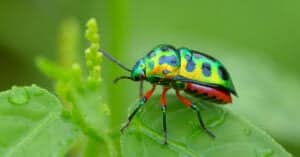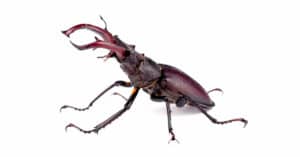Arizona, a state renowned for its diverse landscapes, is home to a wide array of flora and fauna.
From the arid deserts to the lush forests, Arizona’s unique ecosystems provide a habitat for numerous species. Further, many of these species have adapted to the region’s harsh and varying conditions.
Among these creatures are several species of beetles that have not only survived but thrived in the diverse environments found throughout the state.
Beetles help maintain the health and balance of ecosystems. As decomposers, pollinators, and predators, they contribute to the recycling of nutrients, aid in the reproduction of plants, and help regulate populations of other insects. Additionally, beetles serve as a food source for various species. These include birds, mammals, and reptiles, further illustrating their integral role in the food chain.
In this article, we showcase nine fascinating big black beetles that live across Arizona. We also include key characteristics and habitats with each beetle.
1. Desert Stink Beetles (Eleodes spp.)
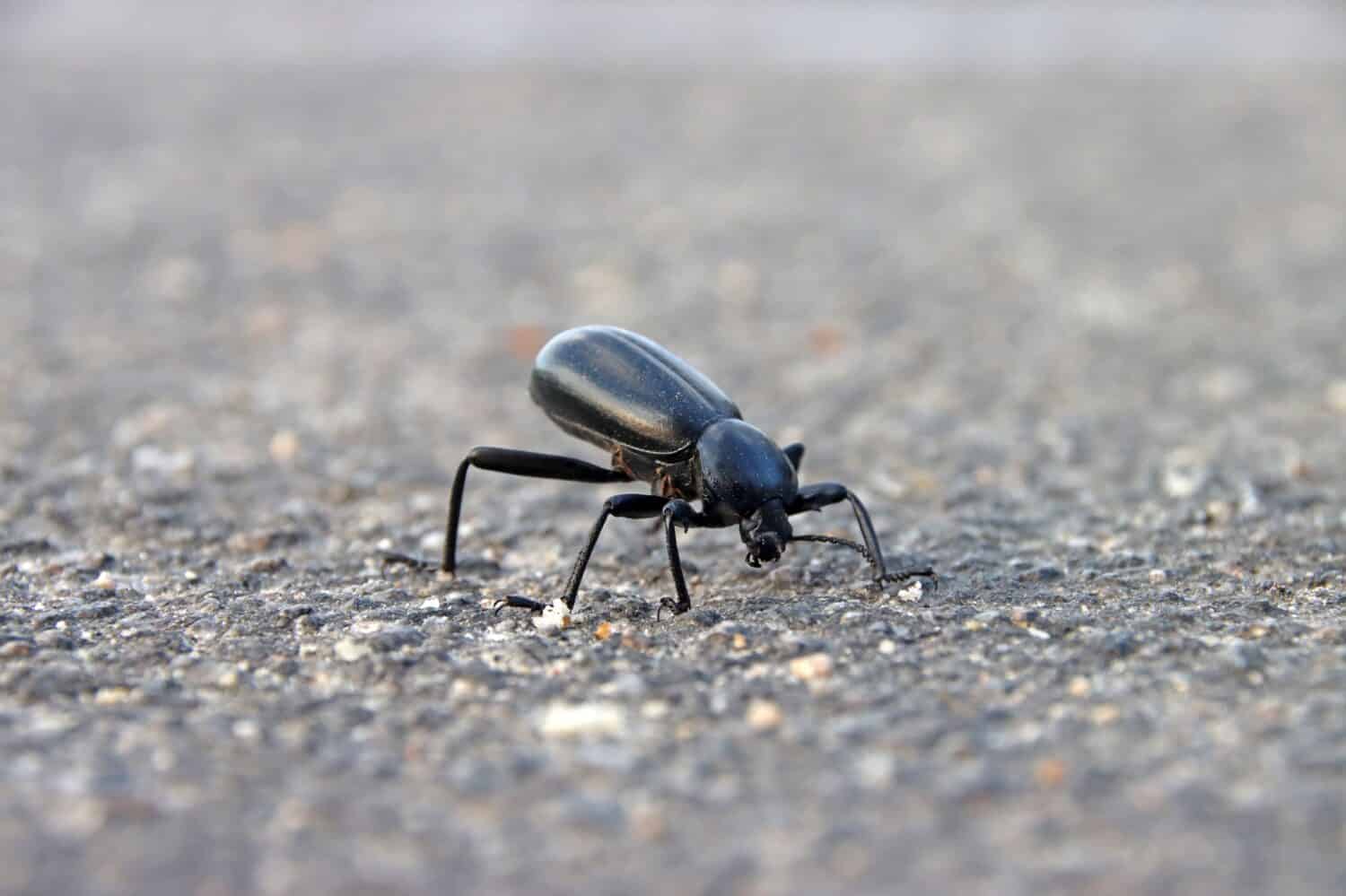
Widespread throughout Arizona is the desert stink beetle.
©thomaslabriekl/Shutterstock.com
Desert stink beetles, belonging to the Eleodes genus, are captivating and widespread beetle species. They live throughout the arid regions of Arizona.
These beetles have a distinctive appearance and unique defense mechanisms. Their defense mechanisms have helped them adapt and thrive in harsh desert environments.
Physical Description
Large, cylindrical, and predominantly black bodies characterize desert stink beetles. They usually measure between half an inch and two inches long.
Their legs are relatively long and robust, allowing them to navigate sandy terrain with ease.
The elytra, or hardened forewings, are fused together to protect their delicate hind wings and provide a shield against predators and environmental threats.
Habitat and Distribution
As the name suggests, desert stink beetles live primarily in desert environments throughout Arizona and the southwestern United States.
You can spot them in areas with sandy or gravelly soil, as well as arroyos, washes, and other areas with sparse vegetation. These beetles are also primarily nocturnal, coming out at night to forage and escape the scorching daytime temperatures.
2. Darkling Beetles (Tenebrionidae Family)
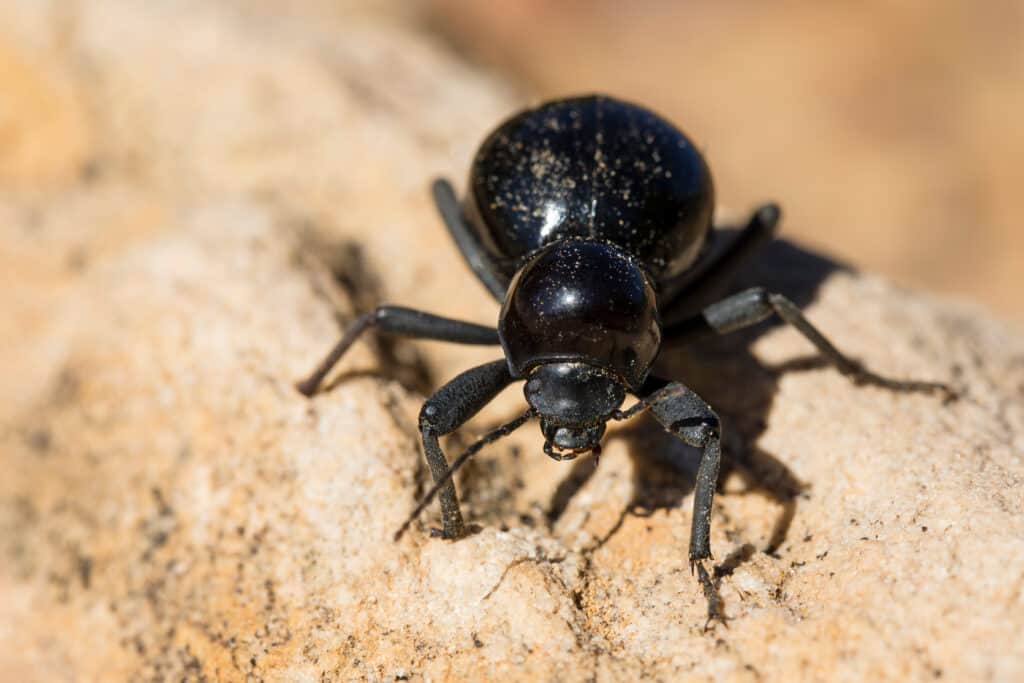
As burrowers, darkling beetles like to be near, or even in, their primary food source.
©Therina Groenwald/Shutterstock.com
Darkling beetles, encompassing a vast number of species within the Tenebrionidae family, are a group of diverse and fascinating insects found in Arizona and across the globe.
These beetles exhibit a range of adaptations that allow them to survive and flourish in various environments, including arid desert habitats.
Physical Description
Dark, matte black or brown coloration and robust, oval-shaped bodies characterize darkling beetles.
Their size varies considerably, with some species measuring less than 0.1 inches while others can grow up to 2 inches in length.
The elytra, or hardened forewings, in many species, offer protection to the delicate hind wings and form a shield against predators and environmental hazards.
Habitat and Distribution
Darkling beetles live in various habitats, including deserts, grasslands, forests, and wetlands.
In Arizona, they are particularly common in arid desert environments, where they have adapted to the harsh conditions and scarce resources.
These beetles are mostly nocturnal, seeking shelter during the day to avoid extreme temperatures and emerging at night to forage for food.
3. Black Blister Beetles (Epicauta spp.)
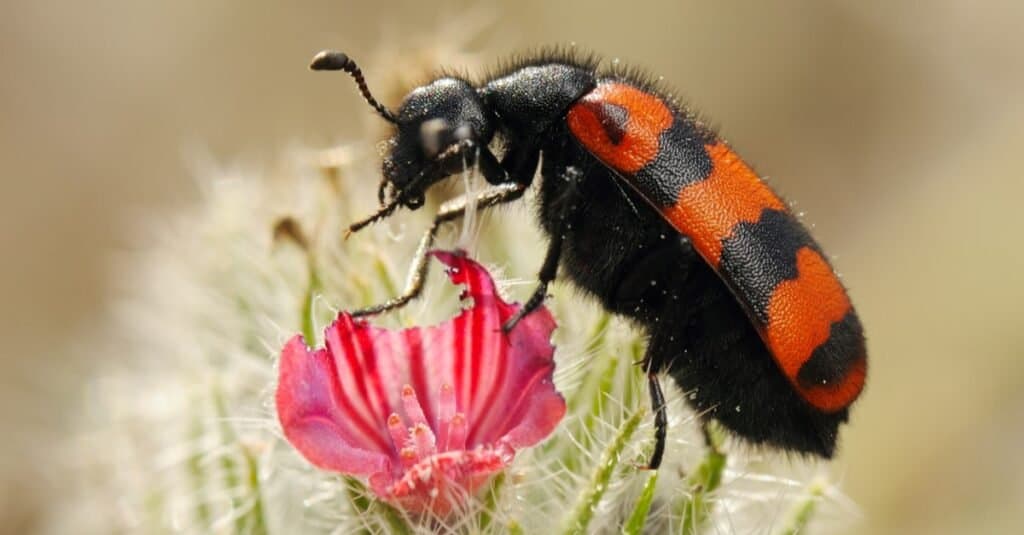
Long, slender bodies characterize blister beetles.
©vblinov/Shutterstock.com
Black blister beetles belong to the Epicauta genus. They’re intriguing and sometimes notorious insects found throughout Arizona and other parts of North America.
Known for their unique appearance and potent chemical defenses, black blister beetles have developed a range of adaptations to survive in their natural habitat.
Physical Description
Elongated, slender bodies, which are usually black or dark brown, characterize black blister beetles.
Adults typically measure 0.5 to 1 inch in length. Their soft, flexible elytra, or forewings, cover and protect the membranous hind wings, which they use for flight. The beetle’s head is often narrower than its pronotum, giving it a distinctive, neck-like appearance.
Habitat and Distribution
Black blister beetles live in various habitats, including agricultural fields, forests, grasslands, and deserts.
In Arizona, you might encounter them commonly in desert environments, as well as in areas with native vegetation or cultivated plants.
These beetles are most active during the warmer months and are usually out during daylight hours, unlike many other beetle species.
4. Carrion Beetles (Silphidae Family)
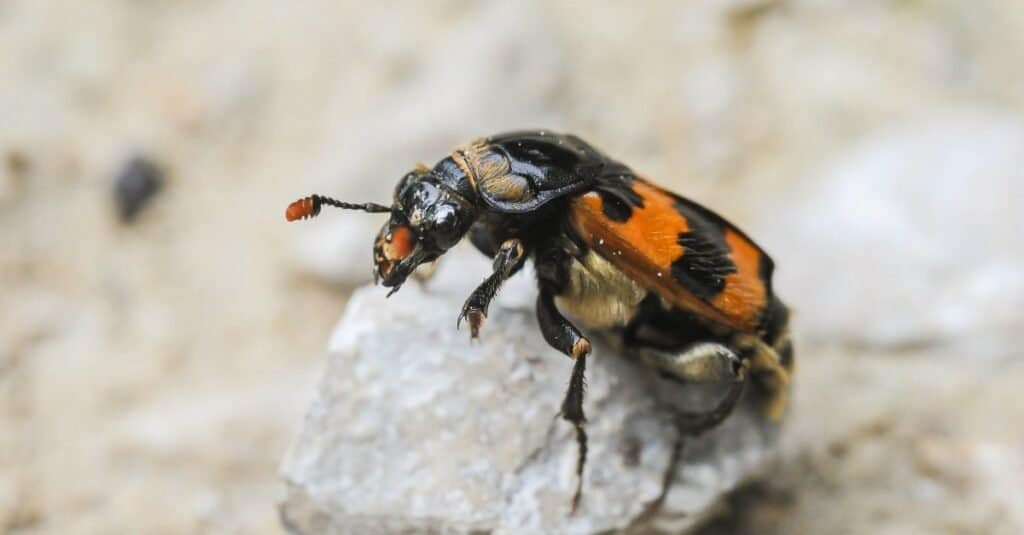
Because of their role in animal decomposition in their ecosystems, carrion beetles are quite important where they’re native.
©iStock.com/Stefan Rotter
Carrion beetles, members of the Silphidae family, are a fascinating group of insects that play a critical role in decomposing dead animals within their ecosystems.
Found throughout Arizona and across the globe, carrion beetles have adapted to their unique niche in nature, showcasing a variety of interesting behaviors and characteristics.
Physical Description
Carrion beetles exhibit a wide range of sizes and appearances, with some species displaying striking color patterns and others featuring more subdued hues.
Many carrion beetles possess a robust, oval-shaped body, with adults measuring 0.3-1.5 inches in length.
The beetles’ elytra, or hardened forewings, typically cover and protect the delicate hind wings, which they use for flight.
Habitat and Distribution
Carrion beetles live in many habitats, including forests, grasslands, and deserts.
In Arizona, they are prevalent in various environments, from arid desert regions to more temperate woodlands.
These beetles are generally more active during the warmer months. They stay near sources of decomposing animal matter, such as carcasses or animal nests.
5. Ironclad Beetles (Zopheridae Family)

With a strong shell of an exoskeleton, ironclad beetles are remarkable creatures.
©GypsyPictureShow/Shutterstock.com
Ironclad beetles, belonging to the Zopheridae family, are a group of remarkable insects with exceptionally tough exoskeletons and unique appearances.
These beetles live throughout Arizona and various parts of the world, showcasing an impressive array of adaptations that allow them to survive and thrive in their chosen habitats.
Physical Description
Robust, compact bodies, which are usually dark brown or black, distinguish ironclad beetles.
The adults can measure 0.2-1.5 inches in length, depending on the species.
Their exoskeletons are incredibly hard and resistant, providing them with unparalleled protection against predators and environmental hazards.
The elytra, or hardened forewings, form a solid shield over the beetle’s body.
Habitat and Distribution
Ironclad beetles can be found in various habitats, including forests, grasslands, deserts, and urban environments.
In Arizona, they are commonly encountered in desert regions and in more temperate areas with native vegetation.
These beetles are primarily nocturnal, seeking shelter during the day to avoid extreme temperatures and emerging at night to forage for food.
6. The Arizona Eyed Click Beetle (Alaus zunianus)
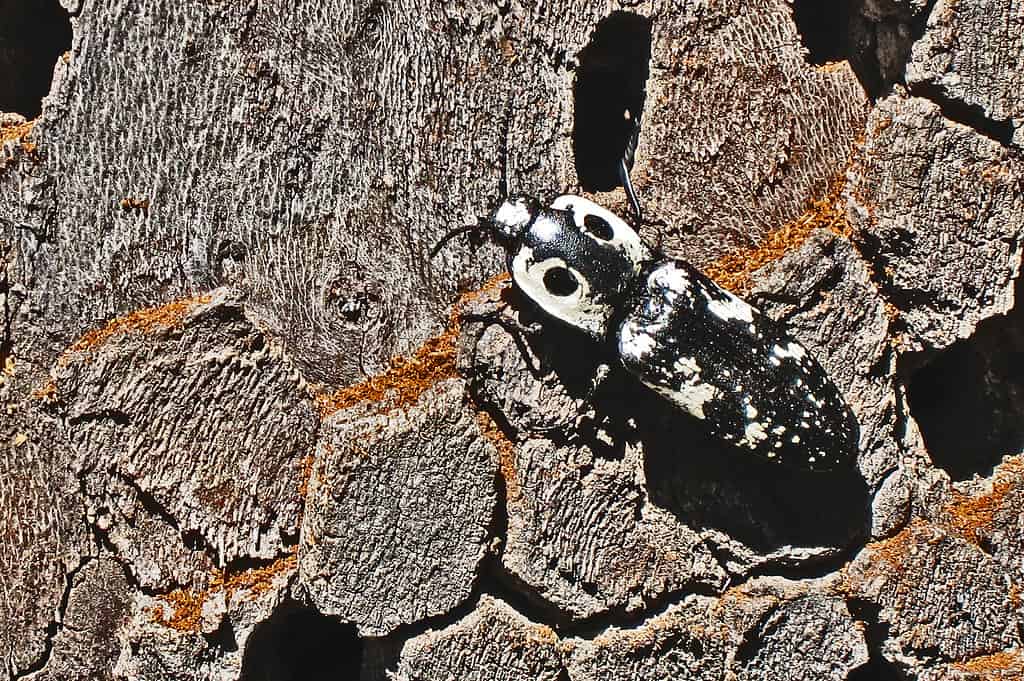
With their unique pattern and coloration, Arizona eyed click beetles are captivating.
©Joseph C Boone/Wikimedia Commons – License
The Arizona eyed click beetle, or Alaus zunianus, is a captivating and distinctive beetle species native to the southwestern U.S.
Known for its unique clicking mechanism and striking appearance, the Arizona eyed click beetle has developed a range of adaptations that enable it to survive and prosper in its natural habitat.
Physical Description
Arizona eyed click beetles are characterized by their elongated, somewhat flattened bodies, which are typically black or dark brown.
The adults measure 1-1.5 inches in length. One of their most striking features is the presence of two large, eye-like spots on the pronotum. These also serve as a form of mimicry to deter predators.
The beetles’ elytra, or hardened forewings, cover and protect the delicate hind wings, which they use for flight.
Habitat and Distribution
Arizona eyed click beetles can be found in various habitats throughout the southwestern U.S., including Arizona, New Mexico, and Texas.
They are often encountered in desert environments, as well as in areas with native vegetation, such as forests and grasslands.
These beetles are primarily nocturnal, seeking refuge during the day to avoid extreme temperatures and emerging at night to forage for food.
7. Palo Verde Root Borer (Derobrachus hovorei)
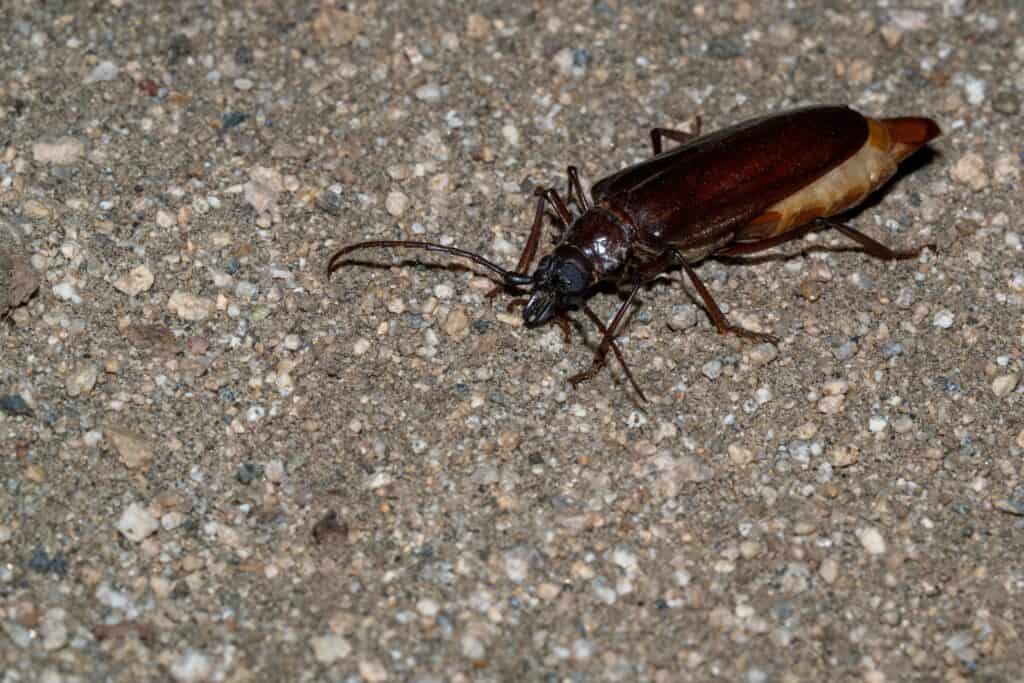
Ranging from two to three and a half inches long, Palo Verde root borers are particularly large.
©Jason Mintzer/Shutterstock.com
Palo Verde root borers are a large and fascinating beetle species native to the southwestern U.S., including Arizona.
Recognized for its impressive size and the impact its larvae have on the root systems of various plants, the Palo Verde root borer exhibits a range of adaptations that contribute to its survival in arid environments.
Physical Description
Palo Verde root borers are characterized by their sizeable, elongated bodies, which are typically dark brown or black.
Adult beetles can measure 2-3.5 inches in length, making them among North America’s largest beetles.
The beetles’ elytra, or hardened forewings, cover and protect the delicate hind wings, which they use for flight. The Palo Verde Root Borer also possesses long, serrated antennae.
Habitat and Distribution
Palo Verde root borers can be found in various habitats throughout the southwestern U.S., including Arizona, Nevada, and California.
They are often encountered in desert environments, particularly in areas with native vegetation, such as the Palo Verde tree, which serves as a primary host for the beetle’s larvae.
These beetles are nocturnal, seeking shelter during the day to avoid extreme temperatures and emerging to forage for food and mates at night.
8. The Western Hercules Beetle (Dynastes grantii)

Male western Hercules beetles can grow a large horn to fight for territory or mating rights.
©Lazybugs/Shutterstock.com
Western Hercules beetles are an impressive and formidable beetle species native to the southwestern United States, including Arizona.
Renowned for its massive size and striking appearance, the Western Hercules Beetle boasts a variety of adaptations that allow it to thrive in diverse ecosystems.
Physical Description
Western Hercules beetles are characterized by their large, robust bodies, which are typically greenish-gray or black.
Adult beetles can measure 1.5-3 inches in length. Males are larger than females, though.
Males also possess a distinctive horn on their heads, which they use for combat and competition with other males during mating season.
The beetles’ elytra, or hardened forewings, cover and protect the delicate hind wings, which they use for flight.
Habitat and Distribution
Western Hercules beetles can be found in various habitats, including forests, grasslands, deserts, and urban environments.
In Arizona, they are commonly encountered in desert regions and in more temperate areas with native vegetation.
These beetles are primarily nocturnal, seeking shelter during the day to avoid extreme temperatures and emerging at night to forage for food and mates.
9. The Rainbow Scarab (Phanaeus vindex)

While rainbow scarabs can thrive in a number of habitats, in Arizona, you’ll encounter them in the desert.
©https://www.flickr.com/photos/cogdog/27916990653/ – License
The rainbow scarab is an intriguing and ecologically significant beetle species. They live throughout Arizona and other parts of the United States.
Renowned for their vibrant coloration and important role in nutrient recycling, rainbow scarab beetles possess a variety of adaptations that allow them to thrive in their chosen ecosystems.
Physical Description
Robust, oval-shaped bodies — which display striking metallic coloration, typically ranging from green to blue and even coppery red — characterize rainbow scarab beetles.
The adults usually measure 0.5-1 inch long. Males of the species possess a prominent horn on their heads, which they use for combat and competition with other males during mating season.
Habitat and Distribution
Rainbow scarabs live in various habitats, from deserts and grasslands to forests and agricultural lands.
In Arizona, they are commonly encountered in desert environments, as well as in areas with native vegetation and livestock.
These beetles are most active during the warmer months and are generally more active during daylight hours.
Key Takeaways
Throughout this article, we have explored the fascinating world of nine big black beetles native to Arizona.
Each species, with its unique characteristics, plays an essential role in maintaining the balance and health of the state’s ecosystems.
Their various adaptations, including water conservation techniques, thermoregulation, camouflage, and reproduction strategies, have allowed them to thrive in the diverse and often harsh conditions found throughout Arizona.
As we develop a deeper understanding of these remarkable beetles and their roles in Arizona’s ecosystems, it is essential to foster appreciation and respect for these incredible creatures.
The photo featured at the top of this post is © Katarina Christenson/Shutterstock.com
Thank you for reading! Have some feedback for us? Contact the AZ Animals editorial team.



